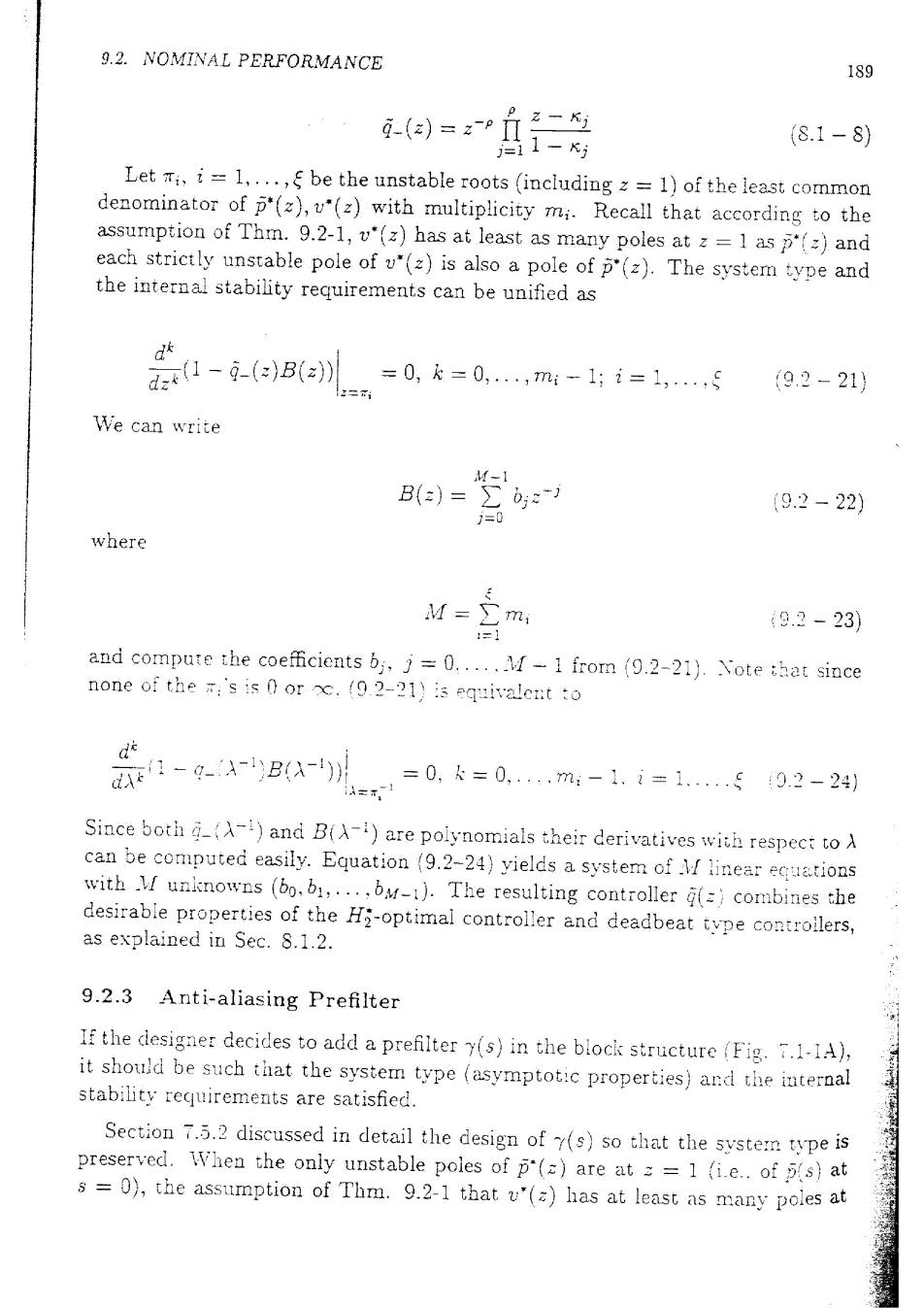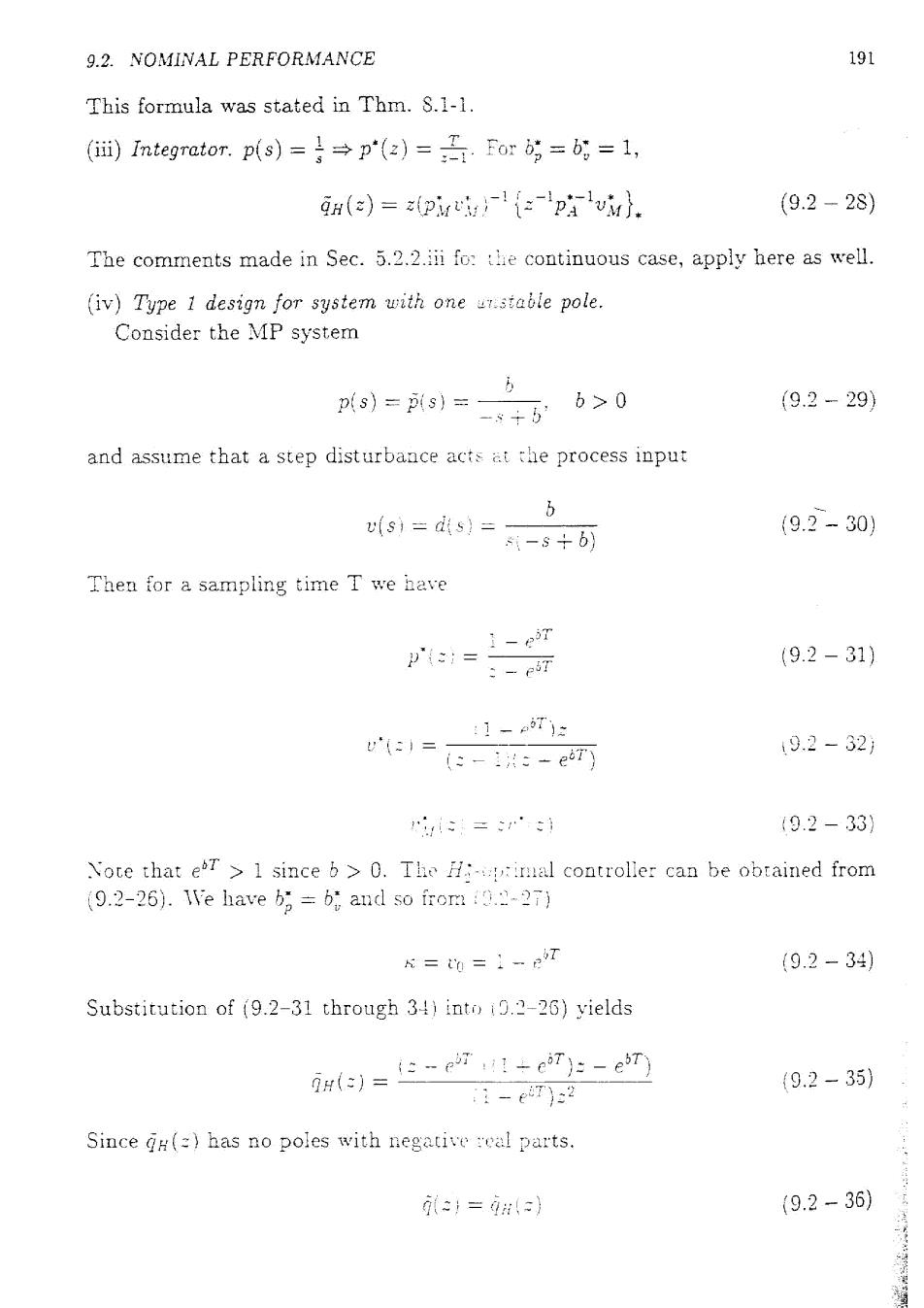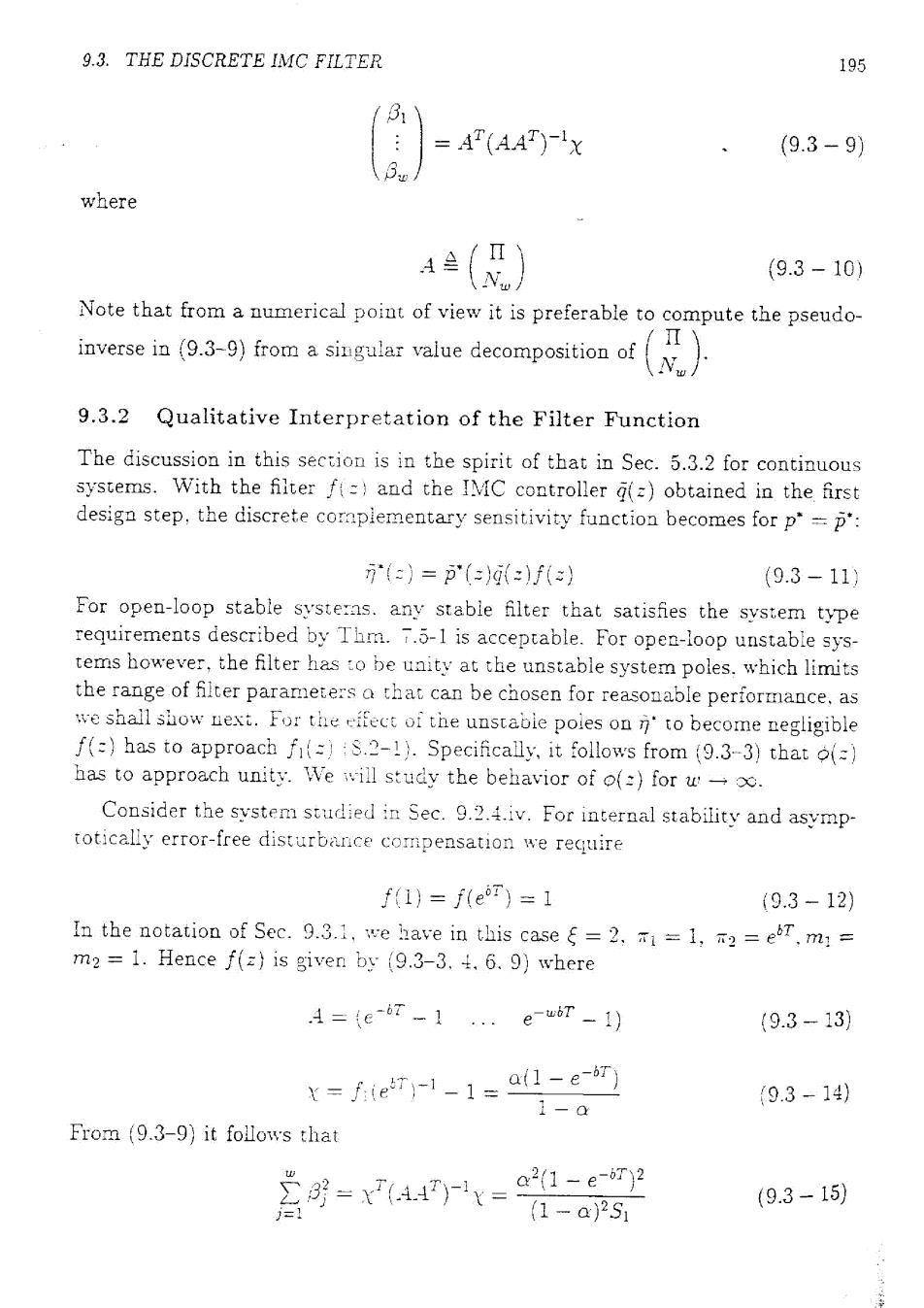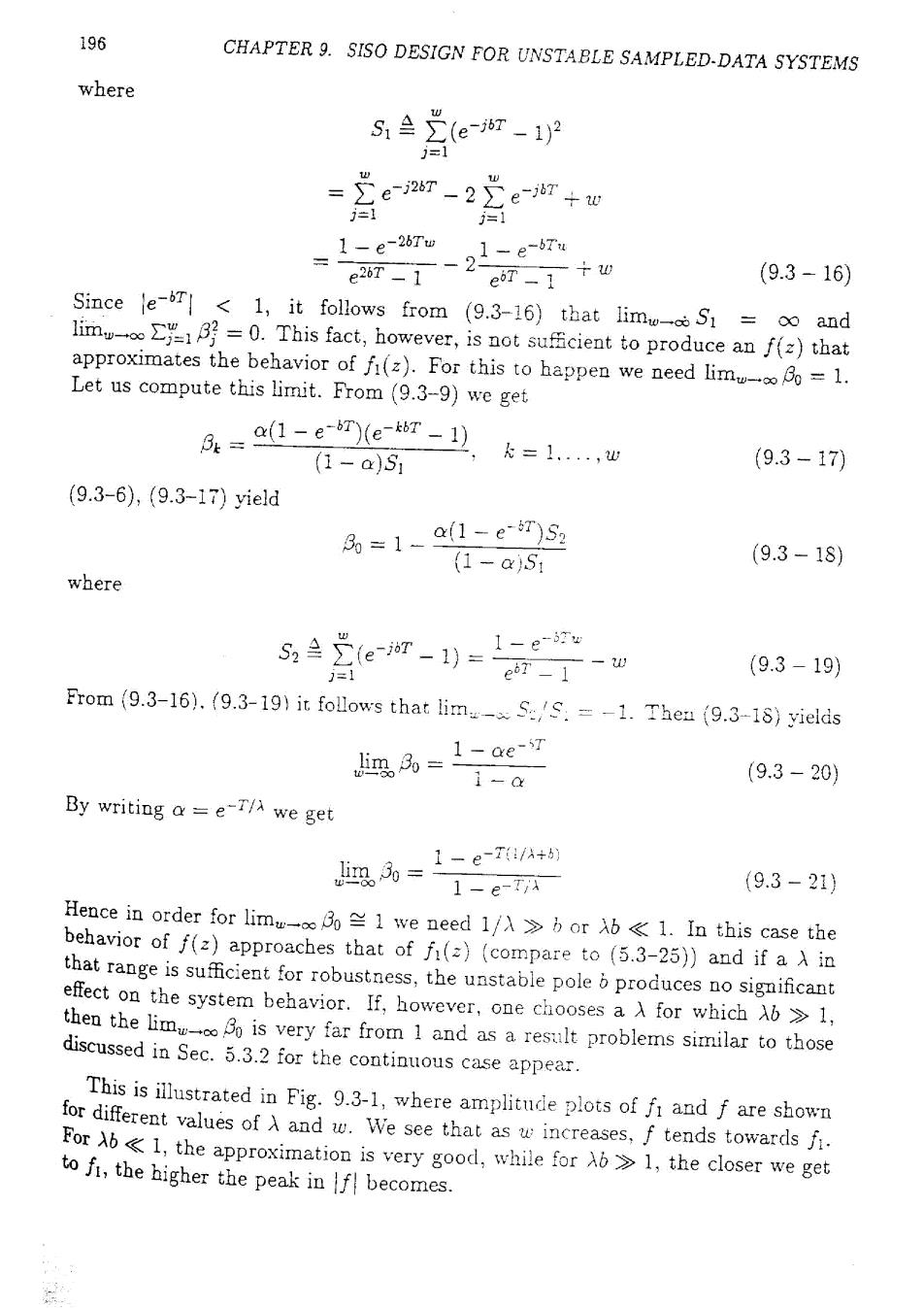
9.2.NOMINAL PERFORMANCE 189 = 之一1 (8.1-8) Letπ:,;=l,.,ξbe the unstable roots(including z=l)of the least common denominator of p*(z),v"(z)with multiplicity mi.Recall that according to the assumption of Thm.9.2-1,v"(z)has at least as many poles at z=1 asp"()and each strictly unstable pole of u"(z)is also a pole of p"(z).The system type and the internal stability requirements can be unified as dk 1-g-(eB(a》=0,k=0,m-1:i=1,…5 (9.2-21 We can write -1 B()=∑ 0 9.2-22) where M=∑m: 9.2-23) =1 and compute the coefficients bj,j=0.....-1 from (9.2-21).Note that since none of the r:'s is 0 or c.(9.2-21)is equivalent to d 1g-ABfA) =0,k=0,..m:-1、i=1..502-24) Since both (-)and B(A-)are polynomials their derivatives with respect toA can be computed easily.Equation (9.2-24)yields a system of linear equations with M unknowns (bo,b1,...,bM-1).The resulting controller (=combines the desirable properties of the H2-optimal controller and deadbeat type controllers, as explained in Sec.8.1.2. 9.2.3 Anti-aliasing Prefilter If the designer decides to add a prefilter y(s)in the block structure (Fig.7.1-1A), it should be such that the system type (asymptotic properties)and the internal stability requirements are satisfied. Section 7.5.2 discussed in detail the design of (s)so that the systemn type is preserved.When the only unstable poles of p"()are at-1 (i.e..of p(s)at s =0),the assumption of Thm.9.2-1 that v"(z)has at least as many poles at

190 CHAPTER 9.SISO DESIGN FOR UNSTABLE SAMPLED-DATA SYSTEMS =1 as p*(),ensures that the internal stability conditions are satisfied for any prefilter which preserves system type. When p"(z)has unstable poles in addition to those at z=1,it is not a simple manner to design y such that condition (ii)of Thm.9.1-1 is satisfied after g(z) has been determined as outlined in the preceding two sections.The preferred approach is to design y(s)first according to Sec.7.5.2.Then one computes p(z)and uses it instead of p'()in Thm.9.2-1 in order to obtain q(z)and subsequently (=)However.this means that the objective function which is minimized is not the one given by 9.2-9)but o、=1-())2(e3 (9.2-25) which does not correspond to the true physical problem.Usually (9.2-25)is a good approximation of(9.2-9). 9.2.4 Design for Common Input Forms In this section we shall examine the -optimal controller (=)given by (9.2-4). for specific systems and inputs. (i)MP System. When p(s)is MP and also strictl proper (all physical systems are strictly proper).p"(=)will have a delay of one unit because of sampling.Hence p= :-1.pi sp'.and (9.2-1)viclds gH=p)-6-c)1(o》-l6u-K =p,:-b8 0.2-26) where K is the constant term inrhe partial fraction expansion of (b)b Equivalently.sinceare se:proper.is the product of the constant terms of the PFE's of b:-..After some algebra we obtain K=Π 1-万 (9.2-27)1 where,,are defined in Thm.2.2-1 and vo is the first non-zero coefficient obtained by long division ofal to the constant term in the PFE of viM(a)》. (ii)Stable System.b=b=1 H(a)=pi)1{:pv} (S.1-5)

9.2.NOMINAL PERFORMANCE 191 This formula was stated in Thm.8.1-1. ()Integrator..p(s)=}→p(2)=.fori5=6=1, gH()=zpM1{z-pivM}. (9.2-28) The comments made in Sec.5.2.2.iii fo:the continuous case,apply here as well. (iv)Type 1 design for system with one uistable pole. Consider the MP system p(s)=p(s)=- 3÷6 b>0 (9.2-29) and assume that a step disturbance acts at the process input b u(s)=dis)=- {9.2-30) -8+b) Then for a sampling time T we have i-e沉 p'= :-e7 (9.2-31) :1-7这 v()= (:-1is-eT) 19.2-32j 1“=9 (9.2-33) Note that eT 1 since b 0.The::ral controller can be obtained from (9.2-26).WVe have b,b;and so from :.-27) 龙=0=上一2T (9.2-34) Substitution of (9.2-31 through 34)into i9.2-26)yields 9x)=-e1-e7:-67 (9.2-35) :-eT}2 Since gH(=)has no poles with negative real parts. =) 9.2-36)

192 CHAPTER 9.SISO DESIGN FOR UNSTABLE SAMPLED-DATA SYSTEMS 9.2.5 Integral Squared Error(ISE)for Step Inputs to Stable Systems The Hi-optimal controller qr(z)minimizes the sum of squared errors (SSE)for a particular input.To correct intersample rippling,the IMC controller (z)is obtained through the modification discussed in Sec.8.1.2. The ISE can be computed for the closed-loop system with(=)from (7.5- 1)which describes the continuous plant output.For the spec.c case of a step setpcint or disturbance input (v=-r or d),we have ho(s)()=v(s)=s-1 and then (7.5-1),(7.5-2)yield e(s)=(1-p(s)(er)s1 (9.2-37) We have 1sE色产d=ere-e (9.2-38) where2 denotes the H2-norm defined in Sec.2.4.4. For step inputs,we find from Table 8.1-1 H(c)=(pi(=)》 (9.2-39) From S.1-11)we have B(=)=1 and therefore =9: 9.2-40) where)is defined in (8.1-5). Heuce we can write ISE=(1-pis)(pileT))g-(e 0.2-41j By following the steps used in the proof of Thm.4.1-3 we can9.2-41)into two parts: ISE=(1-pA(s))s-par(s)(pu(eT))1g-ie (9.2-42) where pa(s)p(s)are defined in (4.1-3 through 41-5) Note that the first termn in (9.2-45)is the minimum ISEhe continuous case.Hence the second term represents the additional ISEis introduced because of the use of a discrete rather than a continous er(designed according to Secs.8.1.1 and 8.1.2.)

9.3.THE DISCRETE IMC FILTER 193 9.3 The Discrete IMC Filter The philosophy behind the IMC filter is the same as for stable systems (Sec.8.2). The filter structure is fixed and only a few parameters are adjustedo meet the robustness objectives.The simplest filter form is f(:)=(1-a): (8.2-1) z-O 9.3.1 Filter Form The discrete IMC filter f(a)has to satisfy the following requirements (i)Asymptotic tracking of external system inputs (setpoints and or distur- bances)-i.e.,(1-p'gf)v has to be stable. (ii)Internal stability-i.e.,af and (1-p'gf)p'have to be stable. Since d:)has been designed so that (i)and (ii)are satisfied for f(:=1.f() should satisfy 1-f:n=0.及=0m-1,i=1,,5 d 9.3-1) where i.m;were defined in Sec.9.2.2.Note that (9.3-1)implies fot=0: ff:)=1at=T、.,Tξ 9.3-2) One can now select a filter of the form f{)=(z)fj() 0.3-3) where o=)=21 9.3-4) =0 and choose the coefficients 3o....,3 so that (9.3-1)is satisfied for sore specified a.The parameter a can be used as a tuning parameter. Note that for=1,:1.m 1,we only need)=:.For the general case (9.3-1)can be transformed into a system of Af linear equations with 30,....3 as unknowns,where M is given by (9.2-23).Lemma 8.2-1 can help simplify the necessary algebra.One should select w >Mf-Iso that the system of linear equations has one or more solutions.When w >Mf the system is

194 CHAPTER 9.SISO DESIGN FOR UNSTABLE SAMPLED-DATA SYSTEMS underdetermined and B,...,3can be obtained as the minimum norm solution. Note that for M=2 one should select w >2 in order to avoid the trivial solution f()=1. The case 6=1,1 was examined in detail in Sec.8.2.Let us now examine the common case where $1,but mi=1 for i=2,...,6.Then (9.3-1) is equivalent to: dk 1-je川=0,k=0,m1-1 (9.3-5a) f元:=1,i=2,,ξ (9.3-5b) The following theorem hoids: Theorem9.3-1.For:=1.S≥2,m:=1fori=2.,ξ,the coefficients 80.....3w must satisfy 9=-8-..-3w 9.3-6) )-1 ξ-1 {2)-1 八 -Q/(1-a) ≥Y 9.3-7) 0 n:-1 0 where 。。 = 9.3-8 and the elements vij of the m.-x w matriz Nw are defined by (8.2-6) 0 for i>j fori≤j (8.2-6) Proof.Follows directlyfrom T5.2-1,(9.3-5)and the fact that f(1)=1. Forξ=1,Thm.9.3-1 reduces :o Thm.8.2-1.Form:=1.the choice w=ξ-l. reduces (9.3-7)to the Vandende form (5.3-4).In general one should select w1=+m-2 and obian 3:.....as the minimum norm solution to (9.3-7小

9.3.THE DISCRETE IMC FILTER 195 =AT(AAT)-x (9.3-9) where 4(风) (9.3-10) Note that from a numerical point of view it is preferable to compute the pseudo- inverse in (9.3-9)from a singular value decomposition of N 9.3.2 Qualitative Interpretation of the Filter Function The discussion in this section is in the spirit of that in Sec.5.3.2 for continuous systems.With the filter f(=)and the IMC controller (=obtained in the first design step,the discrete coraplementary sensitivity function becomes for p"=p': ()=p'():)f) (9.3-11) For open-loop stable systeras.any stabie filter that satisfies the system type requirements described by Thm.7.5-1 is acceptable.For open-loop unstable sys- tems however,the filter has to be unity at the unstable system poles,which limits the range of filter parameters a that can be chosen for reasonable performance,as we shall show uext.For the effect of the unstable poles on n'to become negligible f(=)has to approach f(=):S.2-1).Specifically,it follows from (9.3-3)that (= has to approach unity.We will study the behavior of f)for uoo. Consider the system studied in Sec.9.2.4.iv.For internal stability and asymp- totically error-free disturbarce compensation we require f(1)=f(eor)=1 (9.3-12) In the notation of Sec.9.3.1.we have in this case =2.=1,2=eT.m= m2 =1.Hence f(z)is given by (9.3-3.4.6.9)where A={e-6r-1.eur-1) (9.3-13) t=fie7)1-1=a1-e如 1-a 9.3-14) From (9.3-9)it follows that 宫--源 (9.3-15)

196 CHAPTER 9.SISO DESIGN FOR UNSTABLE SAMPLED-DATA SYSTEMS where 5∑(e7-1)2 J=i se-2&好-2e-6T+w 1=1 1-e-267w 1-e-Tu (9.3-16) Since e-T<1,it follows from (9.3-16)that limw-S oo and lim=0.This fact,however,is not sufficient to produce an f()that approximates the behavior of fi(z).For this to happen we need limo=1. Let us compute this limit.From(9.3-9)we get .=a1-e(et7-1 (1-a)S1 ,k=1w (9.3-17) (9.3-6),(9.3-17)yield 8=1- a(1-e-T)52 (1-a)S1 (9.3-18) where S2兰(eir-1)=e、m =1 (9.3-19) From (9.3-16).(9.3-19)it follows that limS./S.=-1.Then (9.3-18)yields 玛= 1-ae-ST 1- (9.3-20) By writing a=e-T/A we get 照=。源 1-e-T/A+ (9.3-21) Hence in order for lim we need 1/o1.In this case the behavior of f(z)approaches that of fi(=)(compare to (5.3-25))and if a in that range is sufficient for robustness,the unstable pole b produces no significant effect on the system behavior.If,however,one chooses a for which b1, then the li is very far from 1 and as a result problems similar to those discussed in Sec.5.3.2 for the continuous case appear. This is illustrated in Fig.9.3-1,where amplitude plots of f and f are shown for different values of and w.We see that as w increases,f tends towardsfi. For,the approximation is very good,while for1,the closer we get to fi,the higher the peak infbecomes

9.3.THE DISCRETE IMC FILTER 197 102 1 2 入▣0.1 201 102 103 1. 201 02 A 01 1. 入=10 102 102 10-1 1. 01 1c2 日 Figure 9.3-1.Effect of a RHP pole on the discrete IMC filter.T =0.1.6 =1.Solid:f1,Dash: ow=9,Dot-Dash:f1o,w=2

198 CHAPTER 9.SISO DESIGN FOR UNSTABLE SAMPLED-DATA SYSTEAS 9.4 Robust Stability For controllers designed via the IMC design procedure (=paf)Thm.7.6-1 becomes Cor.9.4-1. Corollary 9.4-1 (Robust Stability).Assume that all plants p in the family n ={p: p(i) (9-1) have the same number of RHP poles and that these poles do not become unob- servable after sampliig.Then the system is robusily stable if and only if the IAIC filter satisfies 胡< 0≤w≤π/T (9.-2 where a is a stabilizing controller for the nominal plant p. For stable systems f is arbitrary.Therefore.there always exists a flter f which satisfes (9.4-2:regardless of the magnitude of the uncertainty For unstable systems f is constrained to be unity at the poles of p"outside the ['C. Thus,depending onthere might not exist any filter parameter for which the constraint (9.4-2:is rnet.Indeed,there might not exist any filter--however complicated which satisfies (9.4-2).A minitnum amount of information is necessary or equivaleutly a maximum amount of uncertainty is allowed to stabilize an unstable systemn.The necessary information at=0 can be characterized easily. Corollary 9.4-2.Assume that a filter f is to be designed for a system or dis- turbance pole(s)at s=0-i.e.,f(1)=1.There exisis an f such thut ihe closed loop system is robusily stable for the jamily II described by (9.4-1)only if im(0)<1. Note that contrary to Cor.8.3-2.Cor.9.4-2 is only necessary.For unstabe systems,in general,the filter has to satisfy other constraints in addition to the one at z=1. 9.5 Robust Performance The results in Sec.7.7.2 hold for unstable systems if it is assumed that all pants in the family II have the same number of RHP poles and if the controller and filter f are stabilizing for the nominal plant p